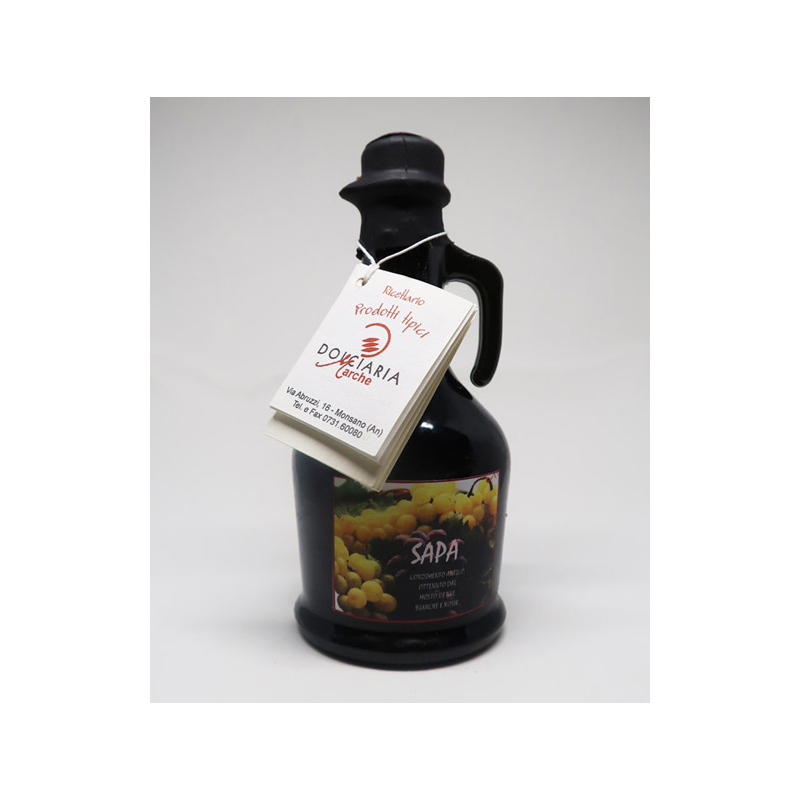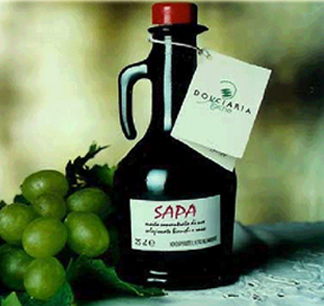Descrizione
– Tipicità –
La sapa è uno sciroppo d’uva che si ottiene dal mosto appena pigiato, di uva bianca o rossa; è detta infatti anche “mosto cotto”.
Il mosto viene versato in un paiolo di rame ed è pronta quando si sarà ridotta ad un terzo della sua quantità iniziale. Nella tradizione la Sapa veniva impiegata nella preparazione di molti dolci essendo più economica e più facilmente reperibile rispetto al miele e allo zucchero semolato.
La Sapa è un condimento tipico marchigiano, considerata tra i sapori tradizionali dell’alimentazione contadina; la sua produzione avveniva ed avviene ancora oggi, durante il periodo della vendemmia.
Un prodotto che sopravvive ancora intatto in ogni casa, squisita insieme ai formaggi stagionati e saporiti, la sapa si accompagna molto bene anche come condimento per l’insalata e come salsa per i gelati di crema e di panna. In estate, con abbondante acqua fresca, diventa un’ottima bevanda dissetante. Aggiunta ad un bel bicchiere di neve fresca costituiva un’inaspettata granatina per i più piccini.
Oggi viene usata per creare uno dei dolci caratteristici del periodo invernale: i cavallucci, cornetti ripieni di sapa e frutta secca che si conservano per molto tempo, per condire la tipica polenta e come ingrediente nell’impasto della “Lonzetta di fico” (altra Specialità tradizionale Marchigiana tipica che puoi trovare nel nostro Market) o semplicemente aggiunta sopra alla fetta.
Dolciaria Marche ha ripercorso le antiche gesta dei nonni con la vendemmia e la pigiatura delle pregiate uve del nostro territorio; come loro dopo una lunga e lenta bollitura otteniamo la preziosa salsa, densa dal colore scuro e dall’inconfondibile sapore dolciastro.
Ingredienti: mosto concentrato di uve selezionate, aromi naturali.
Prodotto in Italia
Leggi di più sulla Sapa nella sezione CURIOSITÀ’
Come si utilizza la Sapa:
La sapa ha molti utilizzi: i contadini erano soliti utilizzare molto la sapa, sia per i dolci casalinghi che per dare più sapore a piatti poveri come la polenta o per intingervi altre pietanze come lo gnocco fritto.
Serve per preparare torte, tortelli al forno, fritti e crostate, si può inoltre spennellare sopra la ciambella, o Bensone, o Bursilan, prima di mettere a cottura nel forno: verrà una bella crosta dorata e dolce; si usa anche per inzuppare i dolci detti Sabadoni, gustose raviole di mele e pere cotogne; una volta si intingeva la polenta nella sapa e si abbina a formaggi erborinati e piccanti, come ad esempio il gorgonzola, a pecorini stagionati e al formaggio di Fossa.
Squisita insieme ai formaggi stagionati e saporiti, la sapa si accompagna molto bene anche come condimento per l’insalata e come salsa per i gelati di crema e di panna: con essa si può ottenere una salsa calda ai frutti di bosco da mettere sul gelato alla crema, oppure sul fior di latte, oppure ancora sul gelato alla panna.
In estate, aggiunta all’acqua, diventa un’ottima bevanda dissetante: i bambini la versavano in un bicchiere pieno di neve e la gustavano come squisita granatina, mentre grandi la versavano in una tazzina piena di neve e la consideravano uno squisito sorbetto.
Sembra anche che il mosto cotto potesse servire per “governare vini deboli”, ovvero dare sapore, zucchero, colore a vini privi di queste caratteristiche, e l’utilizzo finale determinava anche l’uva da utilizzare, bianca, più dolce, come condimento e insaporitore dei piatti e rossa, più scura di colore, per dare colore al vino.
E’ estremamente apprezzata come integratore alimentare per la ricchezza di minerali contenuti ed è impiegata nei digiuni terapeutici: può anche essere consumata a cucchiaio per attenuare i bruciori di stomaco; sapa e latte caldo è un ottimo coadiuvante per il mal di gola e per i malanni da raffreddamento; sapa e camomilla di campo concilia il sonno ed è un buon rilassante, compatibile con la Celiachia.
Ma non solo: per le pelli più delicate preparare un composto di acqua tiepida, menta piperita e sapa, mescolare gli ingredienti tra loro, porre il tutto cospargendolo sul viso, tenere l’impacco per 20 minuti, in questo modo la pelle risulterà liscia, nutrita e visibilmente luminosa.
Leggi di più sulla Sapa nella sezione CURIOSITÀ’
The Sapa:
It is a dark, thick and sweet syrup made from cooking down grape must. It is a very versatile ingredients in today’s cooking: as a seasoning ingredient, it’s an awesome addition to sauces for boiled chickpeas, chestnuts, beans as well as for some fresh and boiled vegetables. You can drizzle some sapa sauce to dress up a tasty cheese plate or grilled polenta dish. Also, it is the main ingredient of the savòr marmalade. The ancient Romans used the compound to sweeten wine and other food instead of honey. Even today sapa is recommended to the home-baking of cakes, pie and pastries. Once upon a time, sapa was the basic ingredient of a simples slush: it was whisked with a fistful of white fresh snow to make kids happy. During hot summer days, it is recommended to dilute sapa with plenty of cold water.
It’s also great as an accompaniment to desserts: do not miss to drizzle sapa on top of a slice of our fig-loaf.
Sapa History:
Sapa is a syrupy sweetening agent made in the Marche region of Italy by simmering down grape juice to reduce its volume. In Italy today, it is called “Mosto Cotto” (cooked must.)
Mosto cotto must not be confused with vino cotto which is the must of any of the local varieties of grapes, heated in a copper vessel until reduced to a half or third of its original volume, and then fermented.
Instead, Sapa or mosto cotto is made by the slow cooking and reduction over many hours of non-fermented grape must. It is heated in a copper vessel until it is reduced to about one-fifth of its original volume and the sugars present have caramelized. It can be made from a number of varieties of local red wine grapes and before the grapes are picked they are allowed to wither naturally on the vine for about thirty days. In Roman times it was known as sapa.
Sapa was one of the main ingredients of farmer’s diet in old times and its production was – and still is – made during the grape pricking season.
The sapa was typically used in the baking of cakes because it was easily home-made and therefore, cheaper than honey or granulated sugar. Sapa is still being used in today’s cooking and it is typically served with a selection of seasoned and tastycheese as well as with fresh salad, fresh cream or creamy flavours to enhance the ice-cream taste.
In summer sapa can be added to fresh water for refreshing drinks. An old saying suggests “add sapa to a full glass of fresh snow and kids will be happy to drink a nice and tasteful slush!”.
Today’s Sapa syrup is a fundamental ingredient to bake one of the most peculiar winter cakes:cavallucci, a croissant filled in with sapa and dried fruit that can be stored for a longtime. Also, sapa can be served as a sauce for seasoning polenta food or for topping of a slice of fig loaf. It is not to forget that sapa is also one of the king ingredients of the fig loaf dough.
At the Dolciaria Marche we have faithfully followed the cooking steps of our grandparents: we have hand-picked the precious grapes of our local vineyards, pressed them and cooked them slowly in a heated copper vessel over many hours until it is reduced to an unmistakable dark, thick and sweet syrup.
In compliance with hygiene and health regulations, we sell sapa in a typical amphora-shaped 500-ml bottle, a perfect product for those who want to discover or rediscover the flavours, aromas and colours of the ancient tradition of the Marche culinary arts.











Recensioni
Ancora non ci sono recensioni.